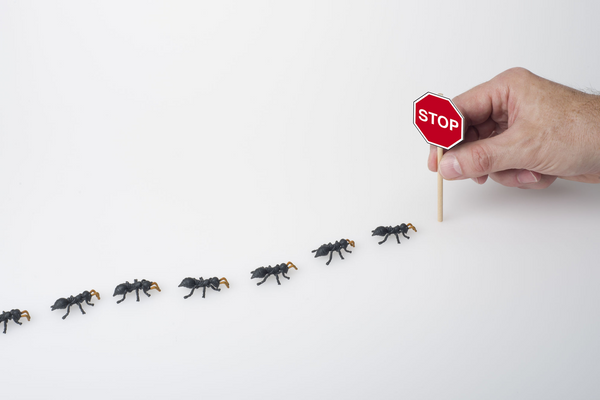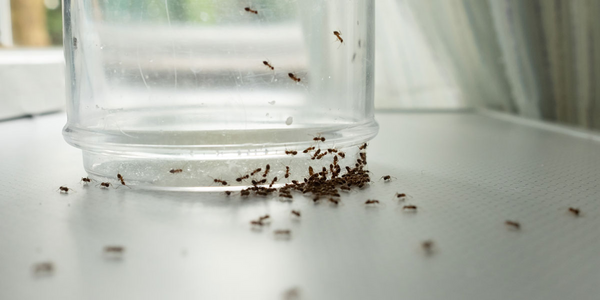Reading time: 5 minutes
Ant Behavior: Understanding These Social Insects
Ants, those small creatures living in well-organized societies, can make our lives a little less peaceful.
Field or Pavement Ant
Field ants, or pavement ants, are distinguished by their brown or black color and small size. Always searching for food, they proliferate in sandy areas and generally build their nests outdoors, near house foundations, in cracks in slabs or asphalt areas. Small sand craters formed by the digging of galleries often bear witness to their presence.
Carpenter Ant
Carpenter ants, often black with red or brown hues, are among the largest ant species found in Canada, measuring 7 to 10 mm. Unlike termites, carpenter ants, also known as wood-boring ants, do not feed on wood. They tunnel into wood softened by moisture to build their nests. Although their natural habitat is the forest, some make their home near homes, particularly in firewood, stumps, and rotting fence or balcony structures.
Sometimes they even infest the interior of houses, attracted by damp wood and especially by the food available in certain rooms (crumbs, sugar, protein sources, etc.). Home infestations often result from the formation of satellite nests, without a queen. Thus, felling a tree or repairing a balcony may be enough to explain the appearance of such a nest.
How to Prevent an Ant Infestation
There are several simple ways to keep ants away from your home.
- Outside:
- Remove wood waste from around the property and keep firewood away.
- Cut back tree branches that touch the house.
- Inside :
- Install screens for all openings and repair them as needed.
- Do not allow household waste to accumulate in the house.
- Inspect damp areas of the house, structural timbers exposed to outdoor conditions, and points of contact between timbers and the ground.
Keep Surfaces Clean in and Around Your Home
The most important measure to prevent ants from entering your home is to maintain a clean environment and store food in airtight containers.
After a meal, it's essential to clean up leftover food and dirty dishes, as they instantly attract ants. Be sure to keep your floors clean in areas where food is eaten to eliminate food crumbs that may go unnoticed.
Ants are attracted to sweet and sticky substances, so wipe down counters and other surfaces with cleaning products or vinegar and water to prevent them from being attracted to these substances.
Seal Cracks Around Your Home
Once food is stored and access points are blocked, seal cracks around your home to prevent ants from entering. Look for potential ant entry points and use caulk to seal cracks around windows, doors, and foundations.
Repair Water Leaks
Ants are attracted to water, so be sure to repair any water leaks as soon as you detect them. Regularly inspect your plumbing for potential leaks under sinks and basins.
Control Ant Colonies Around Your Property
If you find ants in your home, it's likely that there are one or more colonies around your property. To control ants in your home, you also need to take action against the colonies in your yard. Apply ant control products to the colonies and the surrounding area to effectively eliminate these insects and prevent their spread.

Why are there ants in my house?
The main reason ants enter a home is to search for food. This is true for both common ants and carpenter ants. To prevent them from being attracted to food, it is essential to maintain your home and ensure proper waste management. In addition, they are attracted to food and can detect its scent from miles away, thus enticing them to enter your home in search of food. These small creatures can also be attracted to heat and light, and can easily squeeze through small gaps and cracks in walls and floors.
However, the presence of these small undesirables in winter or the sight of winged ants, breeding insects within a colony, probably indicates a strong presence inside the property.
The presence of ants in homes is not uncommon. Whether you live in an apartment or a house, in the city or the countryside, you've probably encountered these insects. These particularly well-organized creatures form colonies that can house up to several million individuals. These colonies can be found outdoors, but also inside homes. Fighting an ant invasion is all the more difficult because a colony can be made up of several interconnected nests.
Once they've settled in your home, ants can cause problems by damaging your furniture by tunneling through it and contaminating your food by leaving droppings. Ants can also be difficult to eliminate because they reproduce quickly. Fortunately, there are several ways to control ants and prevent them from entering your home.
How to Recognize an Ant Infestation
When dealing with an ant infestation, it's often carpenter ants that are the main concern. Signs of a carpenter ant infestation include small piles of sawdust around the house, rustling noises in the walls, hollow tapping sounds, and clusters of insect wings near windows. You may also observe live ants, especially in the evening when they are most active.
If you notice ants crawling across the second-story floor or moving along the walls or across the kitchen floor, you might wonder how they got there and whether there's anything to worry about.
Here are some possible scenarios:
- A few isolated ants are exploring a room, counter, or windowsill. These are usually workers looking for food or a queen looking for a place to establish her colony. It is recommended to eliminate them and remain vigilant to prevent their spread.
- If a large number of ants are constantly and annoyingly moving around a specific area, you can try to control the infestation with ant extermination products.
- Winged ants emerge through cracks in walls or ceilings and attempt to escape through windows. This emergence of winged adults usually indicates the presence of a well-established ant colony somewhere in the house or near the foundation. In Canada, only carpenter ants host winged adults during the winter, while in other species, winged adults leave the colony during the summer.

How to Get Rid of Ants
To effectively eliminate ants, it is essential to destroy the main nest. Here are some steps to follow depending on the location of the nest:
- When the nest is outside the house:
- Attract the ants with Green Way ant bait , which the ants themselves will carry into the nest. This will allow the queen to consume the poison and die. Ants No-More bait stations make this process easier.
- Sprinkle the nest with Diatomaceous Earth for extra action.
- When the nest is inside the house:
If you find ants in the kitchen, especially in spring, they may simply be scouts looking for food. However, their presence in winter, the presence of winged ants (indicative of breeding), or their repeated appearance in the same places likely indicates the presence of a colony inside.
- Use the Bug Bar refillable bait stations and insert the Green Way gel bait to attract ants to consume it and bring it back to the nest. (Caution: this is bait, the ants must consume it and return to the nest with the product in order to eliminate the entire colony, if you see them do not kill them!)
- Sprinkle Diatomaceous Earth in hard-to-reach places.
- Use Terro Ant Stations containing Borax and place them near nests and in areas frequented by ants.
- If you are looking for a fast acting product, Onguard P-22 is also available, and this is a residual product.
If you prefer to have all of the above-mentioned products together, we offer all-in-one ant kits .


